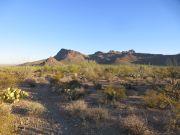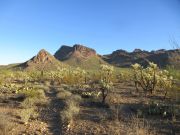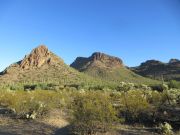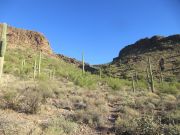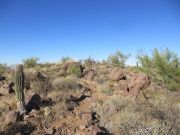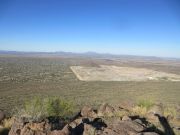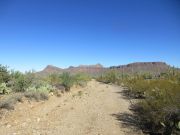
The Mountains of Arizona
www.surgent.net |
| Panther Peak |
• Tucson Mountains • Saguaro National Park • Pima County |
|
Date: November 12, 2024
• Elevation: 3,435 feet
• Prominence: 405 feet
• Distance: 5.8 miles
• Time: 2 hours, 30 minutes
• Gain: 1,255 feet (gross)
• Conditions: Blue skies, cool and pleasant
Arizona
•
Main
•
PB
•
LoJ
Panther Peak rises northwest of Tucson, in the Saguaro National Park's West Unit. It is the western tip of the same massif that includes Safford Peak, and is often climbed by locals in a single outing, the traverse being a particular challenge due to the rocky ridgeline between the two peaks.
Being a Tuesday, I was on my weekly drive to Phoenix. Since the weather has cooled, I always stop somewhere in Tucson to hike a peak to break up the drive. In the last month, I have tackled a quartet of low prominent summits in the Saguaro National Park that lie north of Wasson Peak and south of Safford Peak. In mid-October, I hiked Peak 3022 "Gila Monster Mine Peak", then a few days later, Picture Rocks, then last week, Peak 3263 "Prophecy Wash Peak".
Panther Peak has a trail to its top, but it is a longer hike than the three just mentioned, running almost 6 miles round trip. I was confident I could hike it in about two hours, but to be safe, I left early from Bisbee so that I was in Tucson by 7 a.m., and the trailhead closer to 8 a.m.. I exited Ina Road and went west, parking at the Cam-Boh Picnic Area, due south of the peak and on the edge of the community of Picture Rocks.
I was the only car in the lot for now. I dressed light, wearing shorts because it was all trail to the top. The weather was clear and very mild, temperatures at the moment in the 50s, with expected highs into the 70s. I started walking at 7:45 a.m..
I crossed the road and looked for the Roadrunner Trail. I found it marked by a sign with a person on a horse. The trail is excellent and easy to follow, weaing through the desert plans such as saguaro, creosote, Palo Verde and abundant cactus. The peaks were visible up ahead.
The Roadrunner Trail runs north for 1.4 miles (going by a National Park Service sign), dropping 160 feet over that period to bottom out in the broad Panther Wash. By now, I was directly below the peak and its subsidiaries, including a notable tooth-like summit called Pink Panther. In the wash, the trail is called the Panther Peak Wash Trail. I went left (west).
The information I had was that the trail to the top is not a maintained trail but is regularly trod upon and should be obvious once on it. In the Panther Peak Wash, I wasn't sure what to look for. I walked in it about 500 feet, then saw a State Trust Lands sign. This looked like an old path so I followed it. My hunch was correct. I was on a weak but distinct path that led out of the wash and onto the gentle slopes below Pink Panther.
I then angled right, now trending east and northeast, curling around Pink Panther and aiming ahead for the drainage canyon that leads up to the peak. The trail here was easy to follow but was weak at times.
The trail then starts to gain elevation and parallel above the drainage on its west side. At a large boulder painted with a white blaze, I dropped into the wash. It was very rocky and very brushy. I followed path and lanes when I could find them.
Trip reports mention that this segment is a mush of weak paths, brush and boulders, and runs for about 200 vertical feet. I tried to follow cairns but they were few and far between and not always helpful. I generally followed my senses, and after about ten minutes of these rocks and brush, I found the trail again, now on the east side of the drainage.
The trail just heads upward, not making very many switchbacks and sometimes fairly steep, but it was a fine trail and easy to follow. In time, I was above the drainage. The next goal, the high saddle, was up ahead, still a couple hundred fo feet to gain to get there.
This segment also went well, the trail just making a straight shot upward with very gentle switchbacks and turns. I was soon at the saddle. The summit was west of here, another 400 feet upward.
I found the trail, a little weak at first but then gaining distinction. It went up through slopes of grass and cactus, and a few rock bands that were easy to move through. The slope is slightly steep at first but then moderates. Only then was the summit visible. After a few more minutes, I was at the broad open top.
The summit rocks were easily found. A simple baggie/register was in a cairn atop the largest rock. It was brand new, just placed here last week — and I was already the fifth or sixth person to sign in. Someone was here two days ago. I also looked around and snapped a few iages. Surrounding peaks included Wasson and other Tucson Mountains to the south, Safford to the east, the Tortolitas to the north and looking west, the Silver Bells and other distant ranges on the Tohono O'odham Nation. To the southwest I could make out the bump atop Baboquivari Peak. It had taken me one hour and twenty-five minutes for the ascent, and I spent about fifteen minutes up here having a rest. The day was beautiful and the temperature had risen into the 60s by now. It was very comfortable and enjoyable.
Going down, I followed the trail. Below the saddle but still above the drainage, I heard voices. They were surprised to see me, as I was to see them. There were a couple about my age. They weren't locals, but they've been here often and knew the trails well. I spent about five minutes with them, having a chat. They would be the only people I'd see on the hike.
The hike down the drainage went a little better. I could see paths down I didn't see on the way up. I was soon back on the main trails. I found a slightly-shorter way to get back to the Panther Peak Wash and the Roadrunner Trail, saving me about a half mile. The walk back to my car went quickly, and I was back by 9:15 a.m., a 2-hour and 30-minute round-trip journey.
This was a great hike with great views and it's no wonder it is included within in the National Park boundaries. With clear conditions and blue skies, I had great views the entire way and barely broke a sweat. And the best thing was, I was still on schedule for the rest of my drive.
Exiting, I took the scenic route, going west to Sandario Road then north to Avra Valley Road to Sanders Road, which meets Marana Road, where I then caught the interstate.
The next day, I would hike a couple peaks in the Superstition Mountains, Yellow Peak and Peak 3097.
|
|

